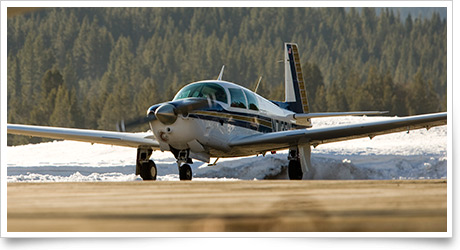training tipsDeep freeze, tight squeeze
Your airport does a great job getting the place cleaned up with minimum interruption of your flying. Now it’s your turn to adjust to the conditions to keep operations safe and efficient.
That idea starts right on the still-bustling ramp. Take a moment after announcing that you are about to start the engine, to make sure that any bystanders are well clear, and alert to your intentions. (Some pilots also operate their aircraft’s rotating beacon before engine start as an added warning.)
Don’t assume that the accustomed ritual of shouting your “prop clear” warning is as familiar to others present as it is to you. Also, reactions to the alert may vary.
“If one isn’t expecting a propeller to suddenly turn and burst into life, it’s going to take a few moments for the warning words to register, and a few more moments to physically react,” a pilot wrote to AOPA, sharing his observations about ramp operations. “Hopefully, the reaction will be in the form of movement and not freezing, but no one stands a chance if we’re turning the prop over as we’re shouting (if indeed anyone ‘shouts’) said warning.”
Once safely in motion, taxiing extra slowly may be only part of the safety package. Airport notams may have warned of high snowdrifts on the margins of runways and taxiways, but you may discover them on your own.
When giving sufficient wingtip clearance to opposite-direction traffic on taxiways, don’t fixate and forget to watch out for those icy patches that could cause you to slide off the pavement and into a difficult spot.
Monitor all ground transmissions, staying alert for any instructions for you to give way to other ground traffic.
You have learned to adjust for your trainer’s loss of forward visibility during landings. Some aircraft, especially many taildraggers, have poor forward visibility during ground operations. (If you see an aircraft making shallow S-turns while taxiing, it probably lacks forward visibility.) Give them a wide berth—especially in the runup area or when holding short for departure.
Airport ground operations always demand vigilance from all participants. When winter conditions add congestion, the team approach to safety is what makes it work. training products
ASA’s Private Pilot eKit provides students the content they need to meet the FAA aeronautical knowledge requirements, and is a training solution for instructors and students seeking a digital solution. The eKit includes The Complete Private Pilot by Bob Gardner, the primary textbook and syllabus; ASA FAR/AIM and Private Pilot Test Prep books; Practical Test Standards and Private Oral Exam Guide; a fiberboard E6-B flight computer and Square Chart Plotter for flight planning; and a standard pilot logbook.
AppStrap has just released a new kneeboard specifically designed to hold the iPad mini. The kneeboard encases the iPad mini and attaches via an elastic band around the leg. The kneeboard costs $39.95.
Note: Products listed have not been evaluated by ePilot editors unless otherwise noted. AOPA assumes no responsibility for products or services listed or for claims or actions by manufacturers or vendors. final exam
Question: If I am intercepted by a law enforcement or military aircraft, how do I know whether they want me to follow them or proceed on course to my destination?
Answer: If you have been intercepted and the pilots of the intercepting aircraft want you to follow them they will typically make a slow level turn, normally to the left, onto the desired heading. The intercepting aircraft will also normally be rocking its wings slightly above your flight path, ahead of you, and to the left. If, on the other hand, you are intercepted and after identifying you the intercepting aircraft decides you can proceed on your way, it will normally perform an abrupt break-away maneuver consisting of a climbing 90-degree-or-more turn to the left without crossing your flight path. Click here for AOPA’s In-Flight Intercept Procedures Checklist.
Got a question for our technical services staff? Email [email protected] or call the Pilot Information Center, 800/872-2672. Don’t forget the online archive of “Final Exam” questions and answers, searchable by keyword or topic. |
 Yesterday’s two-foot snowfall has been cleared from ramps and runways, replaced by towering snow piles and drifts that promise to dominate the airport’s landscape deep into winter.
Yesterday’s two-foot snowfall has been cleared from ramps and runways, replaced by towering snow piles and drifts that promise to dominate the airport’s landscape deep into winter.

